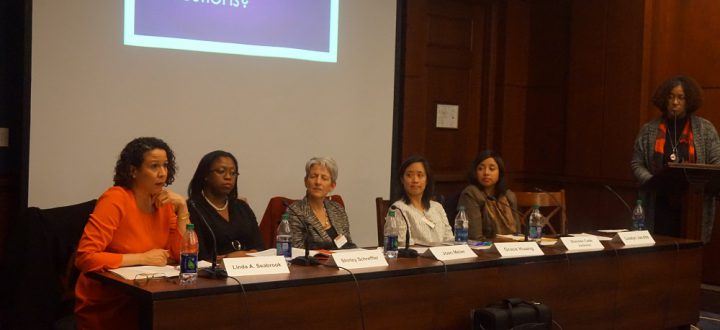7 Reasons Employers Should Address Domestic Violence

Employers face numerous human resource concerns, with limited time and money. Often a decision to focus on a specific problem is not made until the problem becomes significant and costly.
Historically, problems with a social stigma are less likely to receive attention, as both employers and employees may be reluctant to acknowledge that these problems exist.
Domestic violence was a hidden concern that did not show up on the public’s radar screen until relatively recently. Some employers are addressing it, but many more are not. The following are seven compelling reasons that employers should take action on this issue.
Reason 1. Domestic violence affects many employees.
- Nearly one-third of American women (31 percent) report being physically or sexually abused by a husband or boyfriend at some point in their lives.1
- More than one million people report a violent assault by an intimate partner every year in the U.S.2
- At least one million women and 371,000 men are victims of stalking in the U.S. each year. Stalkers often follow the victim to the workplace.3
Reason 2. Domestic violence is a security and liability concern.
- Ninety-four percent of corporate security directors surveyed rank domestic violence as a high security problem at their company.4
- Employers who fail to protect their employees from violence at work may be liable. Jury awards for inadequate security suits average $1.2 million nationwide and settlements average $600,000.5
- In the case of La Rose v. State Mutual Life Assurance Co., Francesia La Rose’s family filed a wrongful-death action against her employer when she was murdered by a former boyfriend at the work site. The employer paid a settlement of $850,000 for failing to protect her after being notified of a specific threat.6
Reason 3. Domestic violence is a performance and productivity concern.
- In one study of batterers, 41 percent had job performance problems and 48 percent had difficulty concentrating on the job as a result of their abusive behaviors.7
- Thirty-seven percent of women who experienced domestic violence reported that the abuse had an impact on their work in the form of lateness, missed work, keeping a job, or career promotions.8
- The Centers for Disease Control and Prevention estimates that the annual cost of lost productivity due to domestic violence equals $727.8 million, with more than 7.9 million paid workdays lost each year.9
Reason 4. Domestic violence is a health care concern.
- The national health care costs of domestic violence are high, with direct medical and mental health care services for victims amounting to nearly $4.1 billion.10
- Among women admitted to an emergency room for violence-related injuries, 37 percent were abused by an intimate partner.11
- In a study on the effects of violence, women who experienced any type of violence or abuse were significantly more likely to report being in “fair or poor” health, and were almost twice as likely to be coping with some form of depression.12
Reason 5. Domestic violence is a management issue.
- In a 2002 survey of senior corporate executives, 91 percent said that domestic violence affects both the private and working lives of their employees.13
- In addition, more than half (56 percent) of those surveyed were aware of employees who have been affected by domestic violence.14
- In a 1994 survey, 66 percent of executives said their companies’ financial performance would benefit from addressing the issue of domestic violence among their employees.15
Reason 6. Taking action in response to domestic violence works.
- After participating in domestic violence training at a factory, the rate of employees asking for workplace counseling services for domestic abuse problems was 14 times what it had been prior to the training.16
- When a sample group of 40 abused employees at the factory began using the domestic abuse counseling services, their average absence rate was higher than the factory’s average absence rate. After using counseling services, the abused employees reduced their absenteeism rates to normal.17
Reason 7. Employers can make a difference.
- Numerous corporations, government agencies and domestic violence experts are already addressing domestic violence, with great success. You can make a difference in your workplace and in the lives of employees who are facing abuse!
References:
1 Collins, K., Schoen, C., Joseph, S, Duchon, L. Simantov, E. & Yellowitz, M. (1999). Health Concerns Across A Woman’s Lifespan: The Commonwealth Fund. 1998 Survey of Women’s Health.
2 U. S. Department of Justice, Bureau of Justice Statistics, (2000). Intimate Partner Violence. NCJ 178247.
3 U.S. Department of Justice, National Institute of Justice (2000). Full Report of the Prevalence, Incidence and Consequences of Violence Against Women. November, NCJ-183781.
4 National Safe Workplace Institute Survey, as cited in Solomon, C.M. (1995). Talking frankly about domestic violence. Personnel Journal, 74, 64-66.
5 Perry, P. (1994). Assault in the workplace. Law, May 1, 41.
6 Burke, D.F. (January, 2000). When employees are vulnerable, employers are too. The National Law Journal.
7 Maine Department of Labor. (2004). Impact of Domestic Offenders on Occupational Safety & Health: A Pilot Study.
8 EDK Associates for The Body Shop, 1997. The Many Faces of Domestic Violence and Its Impact on the Workplace. New York: EDK Associates.
9 U.S. Dept. of Health and Human Services, National Center for Injury Prevention and Control. March, 2003. Costs of Intimate Partner Violence Against Women in the United States. Atlanta, GA: Centers for Disease Control and Prevention.
10 Ibid.
11 U.S. Department of Justice, Bureau of Justice Statistics. (1997). Violence Related Injuries Treated in Hospital Emergency Departments, Special Report.
12 Collins, K., Schoen, C., Joseph, S, Duchon, L. Simantov, E. & Yellowitz, M. (1999). Health Concerns Across A Woman’s Lifespan: The Commonwealth Fund 1998 Survey of Women’s Health.
13 Patrice Tanaka & Company, Inc. (October 16, 2002). News Release: Corporate Leaders See Domestic Violence as a Major Problem That Affects Their Employees According to Benchmark Survey by Liz Clairborne, Inc. Contact Lauree Ostrofsky (212) 229-0500, x 236.
14 Ibid.
15 Roper Starch Worldwide for Liz Claiborne, 1994. Addressing Domestic Violence: A Corporate Response. New York: Roper Starch
16 Urban, B.Y. (2000). Anonymous Foundation Domestic Abuse Prevention Program Evaluation: Final Client Survey Report. Chicago, IL: The University of Illinois at Chicago. Contact byurban@aol.com.
17 Ibid.





